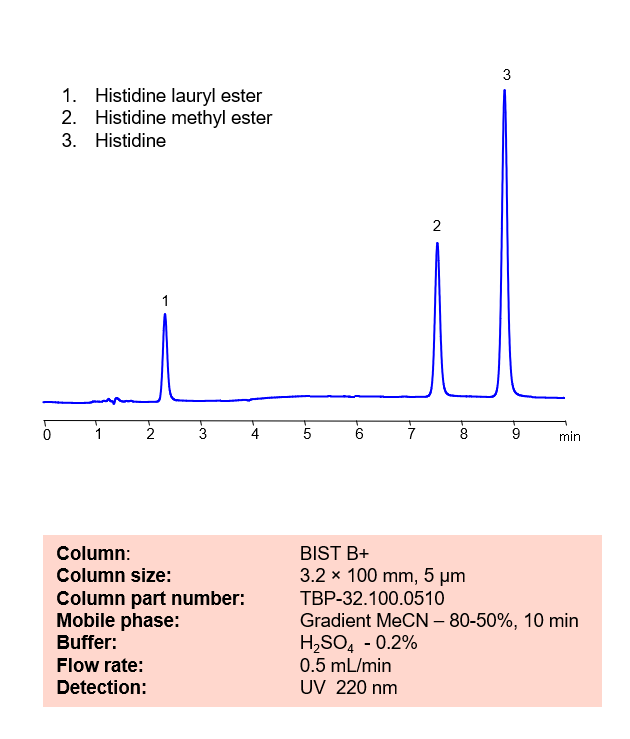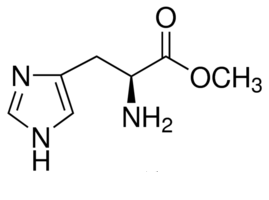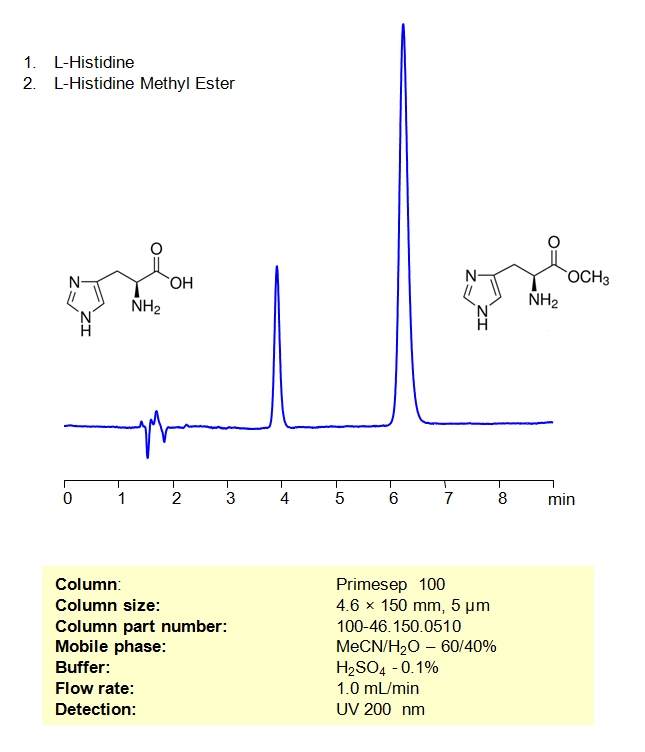| CAS Number | 1499-46-3 |
|---|---|
| Molecular Formula | C7H11N3O2 |
| Molecular Weight | 169.18 |
| InChI Key | BXRMEWOQUXOLDH-LURJTMIESA-N |
| LogP | -0.6 |
| Synonyms |
|
Applications:
HPLC Method for Separation of Histidine, Histidine Methyl Ester and Histidine lauryl Ester on BIST B+ Column
March 23, 2023
HPLC Method for Separation of Histidine, Histidine Methyl Ester, and Histidine Lauryl Ester on BIST B+ by SIELC Technologies
Separation type: Bridge Ion Separation Technology, or BIST™ by SIELC Technologies

Histidine is a naturally occurring essential amino acid that the body uses to repair damaged tissue and generate new blood cells. Histidine Methyl Ester is a histidine decarboxylase inhibitor and can be used to synthesize other biological compounds. Histidine Lauryl Ester is another derivative of Histidine. Using SIELC’s newly introduced BIST™ method, Histidine and its derivatives can be retained and separated on a positively charged, anion-exchange BIST™ B+ column. There are two keys to this retention method: 1) a multi-charged, negative buffer, such as Sulfuric acid (H2SO4), which acts as a bridge, linking the positively charged dipeptide to the positively charged column surface and 2) a mobile phase consisting mostly of organic solvent (such as MeCN) to minimize the formation of a solvation layer around the charged analytes. Using this new and unique analysis method, Histidine and its derivatives can be UV detected at 220 nm.
High Performance Liquid Chromatography (HPLC) Method for Analysis of Histidine, Histidine Methyl Ester and Histidine lauryl Ester
Condition
| Column | BIST B+, 3.2 x 100 mm, 5 µm, 100 A, dual ended |
| Mobile Phase | Gradient MeCN – 80 – 50%, 10 min |
| Buffer | H2SO4 – 0.2% |
| Flow Rate | 0.5 ml/min |
| Detection | UV 220 nm |
| Peak Retention Time | 2.2 min, 7.5 min, 8.9 min |
Description
| Class of Compounds | Amino acid |
| Analyzing Compounds | Histidine methyl ester, Histidine |
Application Column
BIST B+
Column Diameter: 3.2 mm
Column Length: 100 mm
Particle Size: 5 µm
Pore Size: 100 A
Column options: dual ended
Histidine methyl ester

HPLC Method For Analysis Of Histidine and Histidine Methyl Ester Dihydrochloride on Primesep 100 Column
January 27, 2022
Separation type: Liquid Chromatography Mixed-mode
High Performance Liquid Chromatography (HPLC) Method for Analysis of Histidine and Histidine Methyl Ester Dihydrochloride
Histidine and Histidine Methyl Ester Dyhydrochloride are related compounds with interesting uses. Histidine is used in biosynthesis to create proteins, while histidine methyl ester dihydrochloride (a derivative of histidine) is used to create various other compounds.
This amino acid and its derivative can be detected in the low UV regime. Using a Primesep 100 mixed-mode column and a mobile phase consisting of water and acetonitrile (MeCN) with a sulfuric acid (H2SO4) buffer, Histidine and Histidine Methyl Ester Dyhydrochloride can be retained, separated, and analyzed. This analysis method can be UV detected at 200 nm.
| Column | Primesep 100, 4.6×150 mm, 5 µm, 100A |
| Mobile Phase | MeCN/H2O – 60/40% |
| Buffer | H2SO4 – 0.1% |
| Flow Rate | 1.0 ml/min |
| Detection | UV, 200 nm |
| Class of Compounds |
Amino acid |
| Analyzing Compounds | Histidine, Histidine Methyl Ester |
Application Column
Primesep 100
The Primesep family of mixed-mode columns offers a wide variety of stationary phases, boasting unprecedented selectivity in the separation of a broad array of chemical compounds across multiple applications. Corresponding Primesep guard columns, available with all stationary phases, do not require holders. SIELC provides a method development service available to all customers. Inquire about our specially-tailored custom LC-phases for specific separations.
Select optionsHistidine methyl ester
L-Histidine hydrochloride monohydrate





